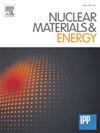通过滑动、旋转和发射钨的间隙增强了空位-间隙湮灭
IF 2.7
2区 物理与天体物理
Q1 NUCLEAR SCIENCE & TECHNOLOGY
引用次数: 0
摘要
实验研究表明,在块状钨中引入合金元素可以有效地减轻辐射引起的膨胀。这种改进是由于合金元素促进了空位和自间隙原子(SIAs)之间的湮灭。然而,控制这一过程的精确原子尺度机制仍不清楚。在这项工作中,我们通过结合分子静力学和动力学模拟研究了自由和合金元素钉住SIA簇的空位的动态湮灭机制。在SIA簇运动的高能中间态的激励下,我们分析了相关的原子轨迹和能量景观,并确定了驱动SIA介导的空位湮灭的三个关键过程:滑动、旋转和间隙发射。这些过程共同扩展了SIAs的有效湮灭区域,超出了静态晶格稳定性计算所预测的有限空间范围。至关重要的是,空位跳变和这些SIA行为之间的动态耦合进一步放大了湮灭体积,为速率理论中假设的大湮灭半径提供了机制基础。这项工作为空位湮灭动力学提供了原子水平的见解,并揭示了辐射诱导的SIA团簇,当被合金元素稳定时,可以作为有效的空位清除剂。这些发现为通过合金设计和晶粒细化的协同策略优化抗辐射材料建立了框架。本文章由计算机程序翻译,如有差异,请以英文原文为准。
Enhanced vacancy-interstitial annihilation via sliding, rotation and emission of the interstitial in tungsten
Experimental studies have demonstrated that introducing alloying elements into bulk tungsten effectively mitigates radiation-induced swelling. This improvement is attributed to enhanced annihilation between vacancies and self-interstitial atoms (SIAs) facilitated by alloying elements. However, the precise atomic-scale mechanisms governing this process remain unclear. In this work, we investigated the dynamic annihilation mechanisms of vacancies with both free and alloying-elements-pinned SIA clusters through combined molecular statics and dynamics simulations. Motivated by the high-energy intermediate state of a SIA cluster motion, we analysed the relevant atomic trajectories and energy landscapes, and identified three key processes driving SIA-mediated vacancy annihilation: sliding, rotation and emission of the interstitial. These processes collectively extend the effective annihilation region of SIAs beyond the limited spatial range predicted by static lattice stability calculations. Crucially, the dynamic coupling between vacancy hopping and these SIA behaviours further amplifies the annihilation volume, offering a mechanistic basis for the large annihilation radii hypothesized in rate theory. This work provides atomic-level insights into vacancy annihilation dynamics and reveals that the radiation-induced SIA clusters, when stabilized by alloying elements, act as efficient vacancy scavengers. These findings establish a framework for optimizing radiation-resistant materials through synergistic strategies of alloy design and grain refinement.
求助全文
通过发布文献求助,成功后即可免费获取论文全文。
去求助
来源期刊

Nuclear Materials and Energy
Materials Science-Materials Science (miscellaneous)
CiteScore
3.70
自引率
15.40%
发文量
175
审稿时长
20 weeks
期刊介绍:
The open-access journal Nuclear Materials and Energy is devoted to the growing field of research for material application in the production of nuclear energy. Nuclear Materials and Energy publishes original research articles of up to 6 pages in length.
 求助内容:
求助内容: 应助结果提醒方式:
应助结果提醒方式:


